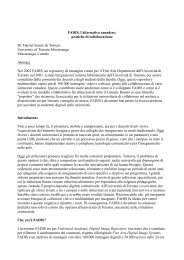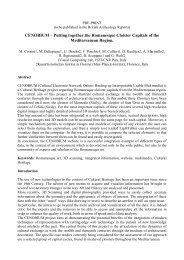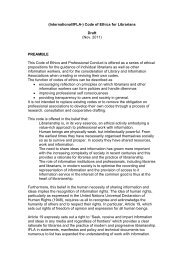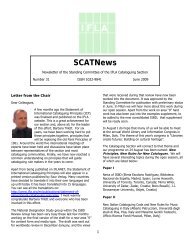English - IFLA
English - IFLA
English - IFLA
Create successful ePaper yourself
Turn your PDF publications into a flip-book with our unique Google optimized e-Paper software.
3<br />
4<br />
5<br />
6<br />
Mo Willems<br />
Don’t Let the Pigeon Drive the Bus!<br />
Hyperion Books for Children, 2003 • ISBN 078681988X 9780786819881<br />
Don’t Let the Pigeon Drive the Bus! is an ingeniously<br />
simple story that instantly connects with the<br />
pre-schooler’s world view. A wily pigeon that<br />
longs to drive a bus sees a chance to make its<br />
dream come true when the bus driver takes a<br />
short break. Funny and exciting by turns, the<br />
often hilarious child-centric text is perfectly<br />
Bill Martin Jr. • Eric Carle, ill.<br />
Brown Bear, Brown Bear, What Do you See?<br />
Henry Holt, 1967 • ISBN 978-0805092448 hardcover (numerous other editions/formats<br />
in multiple languages)<br />
Brown Bear, Brown Bear, What Do you See? has been<br />
a touchstone read-aloud for pre-school since<br />
its publication. Children see a variety of animals,<br />
each a different—and sometimes whimsical—<br />
color and finally, a teacher looking back at them.<br />
The ground-breaking approach of Martin and<br />
Carle, two picture book masters, is deceptively<br />
Jules Feiffer<br />
Bark, George<br />
HarperCollins, 1999 • ISBN 978-0062051851<br />
George’s mother is exasperated when he refuses<br />
to bark like a good little dog. George quacks. He<br />
oinks. He moos! Finally, Mama escorts George to a<br />
resourceful vet who reaches deep down inside the<br />
errant pup, and much to everyone’s surprise, pulls<br />
out a cat! Then a duck, a pig, and finally a cow.<br />
Erza Jack Keats<br />
The Snowy Day<br />
Viking/Penguin, 1962<br />
Now 50 years in print, The Snowy Day chronicles<br />
Peter’s adventures as he explores his urban<br />
neighborhood. Peter gambols through his<br />
mysterious yet familiar snow-covered landscape<br />
experimenting with his footprints, knocking snow<br />
from a tree, and creating snow angels. Seemingly<br />
without effort, Ezra Jack Keats integrated<br />
the world through picture books • books from the usa • 138<br />
matched to the spare yet marvelously expressive<br />
line drawings and understated earth-toned,<br />
palette. Don’t Let the Pigeon Drive the Bus! was a<br />
2004 Caldecott Honor Winner and an adaptation<br />
won the 2010 US Carnegie Medal for Excellence<br />
in Children’s Video.<br />
simple and insightful into the world of young<br />
children. Early childhood educator Martin’s<br />
repetitive, clearly patterned, and predictive<br />
question-and-answer text encourages children<br />
to participate by reading along. Carle’s vivid<br />
tissue paper collages are fully integrated with the<br />
text. This book never fails to engage.<br />
Feiffer’s pen and ink line drawings on pastel paper<br />
reinforce and expand the humorous text. Pulitzer<br />
Prize-winning cartoonist Feiffer provides one final<br />
surprise as George and his proud mother greet<br />
everyone on the street. Preschoolers (and even<br />
adults) are absolutely delighted!<br />
multi-racial characters into the previously allwhite<br />
world of American picture books. Keats is<br />
acclaimed for his bold and brilliant mixed media<br />
(watercolor, gouache, collage) art as well as his<br />
impassioned humanism. The Snowy Day, winner of<br />
the 1963 Caldecott Medal, thrills readers as much<br />
today as it did when it was first published.<br />
7<br />
8<br />
9<br />
10<br />
Margaret Wise Brown • Clement Hurd, ill.<br />
Goodnight Moon<br />
Harper & Row, 1947 • ISBN 9780060775858 (and many other formats and editions)<br />
Goodnight Moon is a deceptively simple story<br />
that endures as a bedtime favorite. Before going<br />
to sleep, a little rabbit says goodnight to each<br />
object in his “great green room”: goodnight stars,<br />
goodnight air, goodnight noises everywhere, and,<br />
of course, goodnight moon. The stylized paintings<br />
by Clement Hurd are wonderfully childlike and<br />
Ed Emberley<br />
Go Away, Big Green Monster!<br />
Little Brown, 1992<br />
Confronting night time fears is part of<br />
childhood as Caldecott-winning artist Emberley<br />
demonstrates in Go Away, Big Green Monster!<br />
Readers construct—then deconstruct—the<br />
monster starting with page one where diecut<br />
yellow eyes on glossy black heavy-duty<br />
pages dominate. Each page turn introduces<br />
additional ‘monstrous’ attributes from a “long<br />
Hand-lettered text and strong, curvilinear<br />
drawings combine to tell the story of a lonely<br />
couple, searching for a cat. On a far away<br />
hillside, the husband discovers “...hundreds of<br />
cats, thousands of cats, millions and billions and<br />
trillions of cats...” After a catastrophic catfight,<br />
the very old man and his wife are left with only<br />
the world through picture books • books from the usa • 139<br />
deliciously full of details that complement—<br />
and extend–the text so masterfully. Although<br />
the book was initially rejected by the library<br />
world (The New York Public Library declined<br />
to purchase it until 1973), Goodnight Moon has<br />
become one of the best-selling American picture<br />
books of all time.<br />
bluish-greenish nose” to “scraggy purple hair.”<br />
Authoritatively, the child proclaims, “YOU DON’T<br />
SCARE ME! SO GO AWAY… “ Each subsequent<br />
page subtracts one of the not-so-scary features<br />
until the final, entirely black page. Emberley<br />
places control in the hands of the childlistener<br />
who states, “and DON’T COME BACK!<br />
Until I say so.”<br />
Wanda Gág<br />
Millions of Cats<br />
G. P. Putnam & Sons, 1928 • ISBN 978-0399233159 (and many other formats and editions)<br />
A peddler who balances his unusual wares on top<br />
of his head—bunches of gray, brown, blue, and<br />
red caps—must outsmart a band of mischievous<br />
monkeys that steal his caps as he naps under<br />
a tree. Exasperated when he can’t retrieve the<br />
caps, the peddler throws his own cap down.<br />
In a clever take on “monkey see, monkey do”…<br />
an undernourished kitten that grows beautiful,<br />
nurtured by their love—a satisfying conclusion<br />
to this immensely pleasing, folk-tale inflected,<br />
story. The repetitive, rhythmic phrasing entices<br />
children to join in the telling. Millions of Cats,<br />
a 1929 Newbery Honor book, is considered to<br />
be one of the first modern picture books.<br />
Esphyr Slobodkina<br />
Caps for Sale: A Tale of a Peddler, Some Monkeys and Their Monkey Business<br />
Harper& Row, 1940 • ISBN 978-0201091472 (and many other formats and editions)<br />
all the monkeys throw down their caps as well.<br />
Slobodkina, a fine artist and graphic designer,<br />
created this sure-fire read-aloud from an old folk<br />
tale and imbued the illustrations with sly humor.<br />
It has been an American picture book favorite<br />
for over 60 years.

















